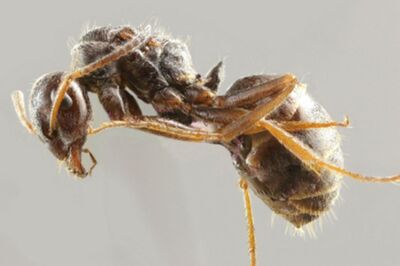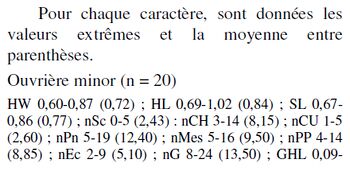Proformica chelmosensis
| Proformica chelmosensis | |
|---|---|

| |
| Scientific classification | |
| Kingdom: | Animalia |
| Phylum: | Arthropoda |
| Class: | Insecta |
| Order: | Hymenoptera |
| Family: | Formicidae |
| Subfamily: | Formicinae |
| Tribe: | Formicini |
| Genus: | Proformica |
| Species: | P. chelmosensis |
| Binomial name | |
| Proformica chelmosensis Lebas & Galkowski, 2019 | |
This species is known from a single large population found on the higher elevation (1800 - 2270 m) slopes of Mount Chelmos, northern Peloponnese, Greece. The ground nests of P. chelmosensis occur in high density. Workers have been observed foraging on the low ground cover that grows on the rocky soil (Lebas & Galkowski, 2019). Workers were active in the middle of the day at an air temperature of around 35°C (Borowiec & Salata, 2021).
Identification
Distribution
Distribution based on Regional Taxon Lists
Palaearctic Region: Greece (type locality).
Distribution based on AntMaps
Distribution based on AntWeb specimens
Check data from AntWeb
Countries Occupied
| Number of countries occupied by this species based on AntWiki Regional Taxon Lists. In general, fewer countries occupied indicates a narrower range, while more countries indicates a more widespread species. |

|
Biology
Castes
Queen
Male
Nomenclature
The following information is derived from Barry Bolton's Online Catalogue of the Ants of the World.
- chelmosensis. Proformica chelmosensis Lebas & Galkowski, 2019: 220, figs. 2-4 (w.q.m.) GREECE.
Unless otherwise noted the text for the remainder of this section is reported from the publication that includes the original description.
Description
Worker
Borowiec and Salata (2022) - Moderately large, polymorphic; minor workers HL: 0.770-1.016 (mean 0.996); HW: 0,521-0.984 (mean 0.760); SL: 0.679-0.984 (mean 0.854); EL: 0.225-0.311 (mean 0.272); ML: 1.08-1.62; MW: 0.46-0.79. Color. Head, mesosoma, petiolar scale and gaster brown to dark brown, pronotum and gaster often paler brown than rest of body, antennae yellow, apical 4-6 antennomeres not or only slightly infuscate, coxa brown, femora mostly dark brown with yellowish apex, tibiae yellowish brown to brown, often gradually paler from distal part to apex, tarsi yellow. Head. 1.3-1.5 times longer than wide, in front of eyes parallelsided, behind eyes regularly rounded, occipital margin convex . Clypeus on the whole surface with distinct longitudinal striation, slightly trapezoidal, its anterior margin convex, sides convergent posterad, posterior margin truncate in the middle, whole clypeal surface with sparse and short, hardly visible appressed hairs, a row of 5 long setae close to anterior margin and one pair close to the base, the longest anterior seta with length 0.170-0.195. Head mostly microreticulate, without longitudinal striation but microsculpture in anterior half of head tends to form circular striation around antennal sockets, whole surface covered with very sparse and short appressed pubescence, with 1-5 short setae in interocular area and 1-3 very short setae in ocellar area, and in occipital part of head with 3-14 erected setae, gena lacking erected setae or 1-3 subdecumbent setae, ventral side of head with 6-8 erected setae. Scape moderately long, 1.1- 1.3 times longer than width of head, thin, distinctly reaching beyond the occipital margin, distinctly, regularly widened from 2/3 of its length, its surface microreticulate but shiny, with short and sparse appressed pubescence on dorsal surface and partly decumbent pubescence on ventral side , without or with 1-3 short, suberect to erect setae. Funicular segments elongate, thin, first segment 2.9 times as long as wide and 2.3-2.4 times as long as second segment, the second funicular segment 1.4 times as long as wide, as long as third segment, the rest of funicular segments clearly longer than broad. Eyes big, elongate oval, approximately 1.5 times longer than wide, 0.27 length of head. Mandibles long, with longitudinal sculpture but shiny, with large apical dent and four smaller, sharp denticles on masticatory margin. Mesosoma. Elongate, in dorsal view distinctly constricted in the middle, 2.0-2.3 times as long as wide, dorsally and laterally distinctly microreticulated, surface indistinctly dull. In lateral view pronotum convex, metanotum and propodeum continuous with deep mesonotal groove. Whole mesosomal surface covered with short and dense appressed pubescence, pronotum with 5-19, mesonotum 5-16, propodeum 4-14 long erected setae. Waist and gaster. Petiolar scale thick in lateral view but broad in anterior view, apex truncate or shallowly concave, without or with 2-6 long setae laterally. Gaster longer than mesosoma, first tergite with diffused microreticulation, subsequent tergites with diffused mixed microreticulation and transverse microstriation, surface shiny, covered with short and sparse appressed pubescence, distance between hairs as large as 1/2-2/3 whole length. First gastral tergite with 8-24 long erected setae and a row of long setae close to posterior margin, second gastral segment in the middle with few suberect setae and a row of long setae close to posterior margin. Legs. Ventral surface of fore femora with 5-6, of mid femora 3-4 and hind femora with 1-2 erected setae.
Major workers HL: 1.262-1.286 (mean 1.274); HW: 1.071-1.0.98 (mean 1.085); SL: 0.992-1.037 (mean 1.015); EL: 0.322-0.325 (mean 0.324); ML: 1.80-1.90; MW: 0.84-0.85. Color. Head, mesosoma, petiolar scale and gaster mostly yellowish brown to brown, genae, pronotum and gaster sometimes slightly paler than the rest of body, antennae and legs yellowish to brown, femora darker than tibiae. Head. 0.9- 1.1 times as long as wide, in front of eyes parallelsided, behind eyes regularly rounded, occipital margin straight . Clypeus on the whole surface with distinct longitudinal striation, slightly trapezoidal, its anterior margin convex, sides convergent posterad, posterior margin truncate in the middle, whole clypeal surface with sparse and short appressed hairs and a row of 5 long setae close to anterior margin, one pair of long setae in the middle and one pair close to posterior margin. Head with micropunctation and microreticulation between punctures, frons with microstriation, whole surface with sparse to moderately dense, short appressed pubescence and 1-8 long erected setae in interocular and ocellar areas and 8-18 suberect to erected setae in occipital part of head, and 4-6 setae on ventral side of head. Scape short, approximately 0.9 times as long as width of head, thin, distinctly reaching beyond the occipital margin, distinctly, regularly widened from 2/3 of its length, its surface microreticulate but shiny, with short and sparse appressed pubescence in basal half and slightly decumbent pubescence in apical half with 1-7 suberect to erect setae. Funicular segments elongate, first segment 2.1 times as long as second, the second funicular segment 1.3 times as long as wide, only slightly shorter than third segment, the rest of funicular segments longer than broad but less clearly as in minor worker. Eyes big, elongate oval, approximately 1.5 times longer than wide, 0.25 length of head. Mandibles moderately long and broad, with longitudinal sculpture but shiny, with large blunt apical dent and 4 smaller blunt denticles on masticatory margin. Mesosoma. Elongate, in dorsal view distinctly constricted in the middle, 2.1-2.2 times as long as wide. In lateral view promesonotum convex, mesonotal groove moderately deep, propodeum convex, whole surface of mesosoma microreticulate, appears indistinctly dull, covered with moderately long and moderately dense pubescence; pronotum with 14-28, mesonotum 10-20 and propodeum 10-29 long erected setae. Waist and gaster. Petiolar scale thick in lateral view, broad in anterior view, widest in the middle then narrowed to base and apex, apical margin triangularly emarginate, apicolaterally with 6-8 long setae. Gaster shorter than mesosoma, slightly globular, first tergite with diffused microreticulation tending to form transverse striation in posterior half of the surface, subsequent tergites microreticulate tending to form transverse striation, surface shiny, covered with moderately long and moderately dense appressed pubescence, distance between hairs as large as 1/6-1/3 their length. First gastral 14-28 suberect to erected setae centrally and a row of long setae close to posterior margin, second and third gastral segment across the middle and close to posterior margin with a row of few long setae. Legs. Ventral surface of fore femora with 6, of mid femora 4-5 and hind femora 3 erected setae.
Queen
Male
Type Material
- Holotype worker, mountain Chelmos, Kalavrita, Peloponnese, Greece, 37°59’52.88"N 22° 11’37.42"E, 1878 m, 29/05/2018 (MNHW-DBET).
- 5 paratype workers, the same data as holotype.
References
- Borowiec, L., Salata, S. 2021. Notes on ants (Hymenoptera: Formicidae) from Western Greece. Annals of the Upper Silesian Museum in Bytom Entomology 30: 1-23 (doi:10.5281/ZENODO.5571258).
- Borowiec, L., Salata, S. 2022. A monographic review of ants of Greece (Hymenoptera: Formicidae). Vol. 1. Introduction and review of all subfamilies except the subfamily Myrmicinae. Part 1: text. Natural History Monographs of the Upper Silesian Museum 1: 1-297.
- Lebas, C., Galkowski, C. 2019. Notes sur le genre Proformica Ruzsky (Hymenoptera, Formicidae). Revue de l’Association Roussillonnaise d’Entomologie 28: 218 – 222.
- Lebas, C., Galkowski, C., Lenoir, A., Perdereau, E. 2023. Description of Proformica borowieci sp. nov. (Hymenoptera: Formicidae), a new species of the genus Proformica Ruzsky, 1902 from Greece. Annales Zoologici 73(3), 569-580 (doi:10.3161/00034541anz2023.73.3.017).











